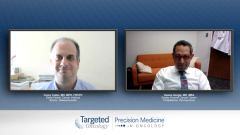
Acute GVHD Prophylaxis Protocol
Key opinion leaders close the discussion by providing insight into their respective protocols for acute graft-vs-host (GVHD) disease prophylaxis.
Episodes in this series

Usama Gergis, MD, MBA: What’s your backbone of acute GVHD [graft-vs-host disease] prophylaxis at Dana-Farber [Cancer Institute], Corey?
Corey Cutler, MD, MPH, FRCPC: In the reduced-intensity setting, we use tacrolimus, sirolimus, and methotrexate for the majority of our patients. In the ablative setting, I still use the combination therapy of tacrolimus and sirolimus based on BTM CTN 0402 and Dr Joseph Pidala’s work in the unrelated setting. My colleagues use a little less sirolimus, and so tacrolimus-methotrexate, but we are actively participating in the CTN study, looking at the combination of PT-Cy [post-transplant cyclophosphamide] in comparison with tacrolimus-methotrexate, and we are participating in a number of clinical trials. Not too many of our patients are getting nonstudy therapy at this point, which is a great thing.
Usama Gergis, MD, MBA: Great. I’ll do a little self-promotion and tell you what we use here [at Sidney Kimmel Cancer Center]. Again, this is new to me. I came from Weill Cornell Medical College, where we’ve given everybody ATG [anti-thymocyte globulin] and Campath [alemtuzumab]. I came here, and everybody has been getting post-transplant cyclophosphamide with tacrolimus and CellCept. There are 2 cool points. We’ve been doing post-transplant cyclophosphamide here since before 2005, so very early on. This is the backbone for everybody; haplos, match-related, unrelated. We don’t do cords here, but the cool thing about the way we do post-transplant cyclophosphamide is what we call a 2-step. We first give 2 times 108 CD3 cells followed by cyclophosphamide and then followed by CD34-selected stem cells. It’s an institution’s experience, and we just published our data for match-related sets. Acute GVHD is 5%.
Corey Cutler, MD, MPH, FRCPC: Very impressive.
Usama Gergis, MD, MBA: Dr Neal Flomenberg and his colleagues here have been spearheading that.
Corey Cutler, MD, MPH, FRCPC: All right. With that, we will wrap up. In terms of final comments, we are very fortunate to have an agent that’s FDA approved in the therapy of steroid-refractory acute graft-vs-host disease. There’s lots of activity on the research side and lots of promising compounds and promising development pathways. Hopefully when we have this conversation in a couple of years, we’ll be having a very different 1 and talking about all our successes in acute graft-vs-host disease. Dr Gergis, thank you very much for joining me, and we thank you all for listening.
Usama Gergis, MD, MBA: Thank you, Corey. Thank you, everyone.
Transcript edited for clarity.










































